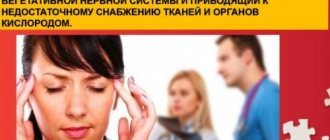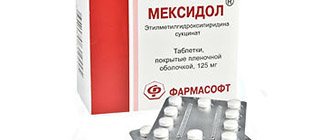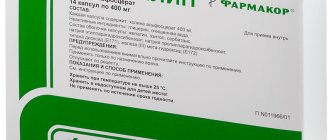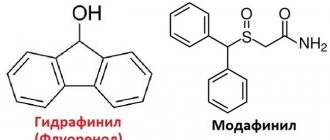The effectiveness of treatment and rehabilitation of patients suffering from brain function disorders depends on the prescribed therapy regimen. In most cases, doctors recommend a set of drugs that are similar in action and belong to the same pharmacological group. These include Cortexin and Mexidol.
Cortexin and Mexidol are prescribed for the treatment and rehabilitation of patients suffering from disorders of brain function.
How they affect the body
Cortexin contains an active element that consists of a low molecular weight peptide from the brain of pigs and cows. The effectiveness of this medication is based on the stabilization of metabolic processes in nerve cells. The active substance helps to enhance the protein-synthetic functionality of tissues. Cells are protected from oxidation and hypoxia. The drug helps restore memory after traumatic brain injury, stroke and the onset of neurodegenerative diseases.
Mexidol is considered an antihypoxic agent. Its effect is aimed at optimizing energy processes in neurons. The drug improves the protection of cell membrane lipids from oxidative processes and reduces the susceptibility of brain tissue structures to a lack of oxygen.
Using Mexidol and Cortexin simultaneously
So, problems that arise after a traumatic brain injury or other brain damage, in most cases, are eliminated with the help of Cortexin or Mexidol. But their effect is enhanced if complex therapy is used. As a rule, these are vascular medications. It is very good if the doctor prescribes taking Cortexin and Mexidol at the same time. After all, an antioxidant such as Mexidol enhances the effect after taking the first remedy. Thus, the course of treatment with Mexidol includes ten procedures. And the use of tablets of this antioxidant called Mexidol is favorable for intravenous administration of the drug.
In this case, Cortexin and Mexidol contribute to positive rehabilitation after receiving traumatic brain injuries.
Considering the compatibility of Cortexin and Mexidol in ischemic brain damage, positive dynamics are also observed. For example, people who, after a stroke, take only Mexidol, may experience an unreasonable feeling of fear, memory impairment, they may experience fatigue and slow recovery of speech. But patients for whom the doctor prescribes Mexidol and Cortexin injections at the same time recover much faster from such a serious illness. If you take only Mexidol, you will also get a positive result, but a little later.
In patients with cerebral circulatory disorders, after the doctor has jointly prescribed the two medications in question, the neuropsychological state significantly improves. Their memory begins to work better, speech is restored much faster, they gain confident orientation in the area, and there is no feeling of anxiety and night sleep improves.
In addition, it is safe to say that the metabolic, neuroprotective and antihypoxic effect of medications has a beneficial effect on the rehabilitation of patients who have suffered a stroke. So, these drugs are compatible, and you can inject medications together to achieve maximum positive results on the path to recovery.
Which is better: Cortexin or Mexidol?
Which drug is best can only be determined by the attending physician based on the indications and condition of the patient. Both medications exhibit nootropic, neuroprotective, antioxidant and tissue-specific effects. The mechanism of action of the drugs is similar, but the difference lies in the price.
Treatment of children
Prescribing drugs for children
If treatment is necessary for a child, the question may also arise: Are Cortexin and Mexidol allowed to be injected together? This decision is made solely by the attending physician. If the benefit of taking these drugs together outweighs the risk, then such a combination is allowed. In any case, you should always consult several specialists. But it is worth noting that in children who have cerebral palsy, the combined use of medications improves cognitive function.
As for the daily dose for children, it should immediately be noted that for children Cortexin is initially produced in a small dosage, which is what you should buy. This also applies to Mexidol. You should never change the dosage yourself, otherwise you can only harm the baby. Children weighing less than twenty kilograms are administered 0.5 mg per kilogram of weight. And for everyone else - ten milligrams once a day.
Before using any medicine, be sure to read the instructions and consult your doctor. After all, like any medicine, these medications also have certain contraindications. If you follow these simple rules, a positive result will be achieved.
Indications for use
The instructions for use indicate that Mexidol is prescribed for:
- acute disturbance of blood flow in the brain,
- traumatic brain injury,
- neurocirculatory dystonia syndrome,
- the occurrence of anxiety,
- myocardial infarction,
- development of primary open-angle glaucoma,
- the appearance of symptoms of intoxication,
- Alzheimer's disease,
- purulent and inflammatory processes in the abdominal cavity (pancreatitis or peritonitis).
Kononova Natalya Evgenievna
Neurologist, pediatric neurologist, chiropractor, doctor of the highest category
The seizures were mild and infrequent, not similar to the classic episyndrome. For several months, examinations were carried out (EEG, MRI under anesthesia (!), after which the child had a very difficult recovery). As a result, no pathological changes were detected and anticonvulsants were prescribed for six months. Moreover, all this time the child physically developed normally in accordance with his age. After starting medication, development slowed down sharply. Now the baby is 2.5 years old, developmental at 9 months, and until recently he continued to take anticonvulsants.
It is clear that Actovegin did not cause it, but provoked convulsions against the background of existing functional disorders of the central nervous system. There were no indications for its appointment. Just as there was and is no need to take anticonvulsants, which suppress the functional activity of the brain and inhibit the development of the child.
Did the neurologist prescribe medication? Let's find out!
Recently I had the fortunate opportunity to talk with a wonderful rehabilitation specialist from Germany, Elke Wilitzke. According to her, neither vascular drugs nor nootropics (drugs that stimulate the brain) are used outside the hospital in young children, even in cases of organic brain damage. With the exception of anticonvulsants in the case of severe malignant seizures. If hydrocephalic-hypertensive syndrome progresses, shunting is performed.
Our neurologists often prescribe diuretics (diacarb) to dilate the cavities of the brain, in order to “remove excess fluid from the brain.” And babies in most cases react negatively to this - regurgitation, sleep disturbances, excitability. There is nothing “extra” in the brain. If there is a violation of liquorodynamics and venous outflow, it is necessary to influence the cause, and not the effect. And the reason is most often damage to the occipital bone and cervical spine, and this can be effectively resolved by an osteopathic doctor.
But from the first days of identifying the problem, they begin active rehabilitation (more correctly, habilitation), including special classes 2 times a week using the Bobath, Vojta and sensory integration methods, as well as training parents in these techniques.
It's no secret that their results are much better than in Russia. This is confirmed by patients who, in difficult cases, try to get to Germany.
Osteopathic treatment of children
Osteopathically, you can improve blood flow, liquor dynamics and the functioning of the brain and all body systems. But the problem remains of how to effectively stimulate the brain and development. Therefore, it is with great enthusiasm that we begin to introduce these methods here too.
Thus, in the absence of organic pathology of the brain, we do not recommend taking any medications! No “vitamins” for the brain, and especially no serious drugs that are indicated only for adults (nootropics, cinnarizine, Cavinton, Actovegin, etc.).
And from now on, we, in turn, will very strictly demand that our patients adhere to these recommendations. If necessary, you can always make an appointment or consultation with our specialists.
How to take Cortexin and Mexidol together
Both medications are available in solution form. If they are used simultaneously, their effect is enhanced. However, mixing drugs in one syringe is not recommended. The break between procedures should be 1-2 hours.
Mexidol can also be taken in tablets. The average dosage is 200-500 mg.
Cortexin is pre-mixed with procaine, saline, sodium chloride or water for injection.
Mexidol
Antioxidant drug.
The mechanism of action of the drug Mexidol is due to its antioxidant, antihypoxic and membrane protective effects. The drug inhibits lipid peroxidation, increases the activity of superoxide dismutase, increases the lipid-protein ratio, reduces membrane viscosity, and increases its fluidity. Mexidol modulates the activity of membrane-bound enzymes (calcium-independent phosphodiesterase, adenylate cyclase, acetylcholinesterase), receptor complexes (benzodiazepine, GABA, acetylcholine), which enhances their ability to bind to ligands, helps preserve the structural and functional organization of biomembranes, transport of neurotransmitters and improve synaptic transmission. Mexidol increases the content of dopamine in the brain. Causes an increase in compensatory activation of aerobic glycolysis and a decrease in the degree of inhibition of oxidative processes in the Krebs cycle under hypoxic conditions with an increase in the content of ATP and creatine phosphate, activation of the energy-synthesizing functions of mitochondria, stabilization of cell membranes.
The drug improves metabolism and blood supply to the brain, improves microcirculation and rheological properties of blood, and reduces platelet aggregation. Stabilizes the membrane structures of blood cells (erythrocytes and platelets) during hemolysis. It has a lipid-lowering effect, reduces the content of total cholesterol and LDL.
The anti-stress effect is manifested in the normalization of post-stress behavior, somato-vegetative disorders, restoration of sleep-wake cycles, impaired learning and memory processes, reduction of dystrophic and morphological changes in various structures of the brain.
Mexidol has a pronounced antitoxic effect in withdrawal symptoms. Eliminates neurological and neurotoxic manifestations of acute alcohol intoxication, restores behavioral disorders, autonomic functions, and is also able to relieve cognitive impairment caused by long-term use of ethanol and its withdrawal. Under the influence of Mexidol, the effect of tranquilizing, neuroleptic, antidepressant, hypnotics and anticonvulsants is enhanced, which makes it possible to reduce their doses and reduce side effects.
Mexidol improves the functional state of ischemic myocardium. In conditions of coronary insufficiency, it increases collateral blood supply to the ischemic myocardium, helps maintain the integrity of cardiomyocytes and maintain their functional activity. Effectively restores myocardial contractility in reversible cardiac dysfunction.
Special instructions for the use of Cortexin and Mexidol
Medicines should be used with caution if there is a history of allergies or bronchial asthma.
Pregnancy and lactation
The drugs cannot be used during pregnancy and breastfeeding, since the active elements pass through the placental barrier and penetrate into breast milk. This can adversely affect the formation of the fetal nervous system.
Childhood
Cortexin is used in pediatric practice for the treatment of neurological diseases in children. The dose and duration of treatment are prescribed by the doctor.
Elderly age
Mexidol is prescribed to older people for Alzheimer's disease, necrotizing pancreatitis, and dementia.
What is the difference
Despite the fact that the drugs are similar in therapeutic effect, there are a number of differences between them.
Compound
The active ingredient of Mexidol is ethylmethylhydroxypyridine succinate, which has membrane protective, antihypoxic and nootropic effects. Cortexin has the same pharmacological properties, but it contains a polypeptide complex obtained from the cells of the cerebral cortex of cattle.
Release form
Mexidol is available in the form of a solution for intramuscular or intravenous administration. Cortexin is a lyophilic powder from which a solution for intramuscular administration is prepared.
Age
Mexidol is not used in pediatric practice. Cortexin is prescribed to patients under one year of age and older.







